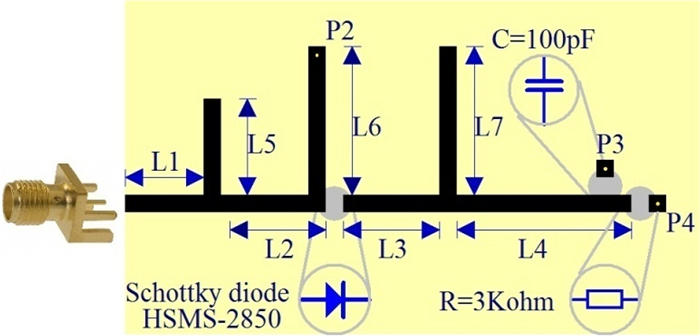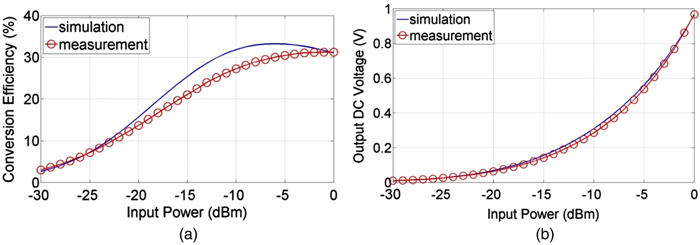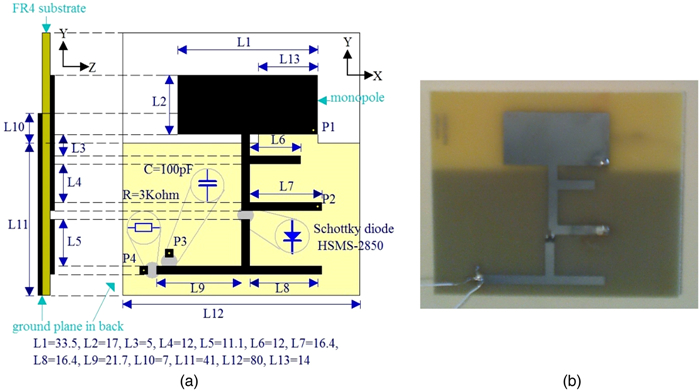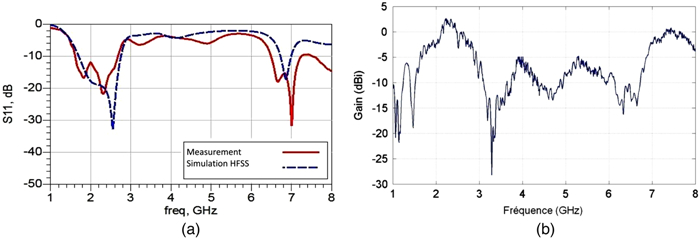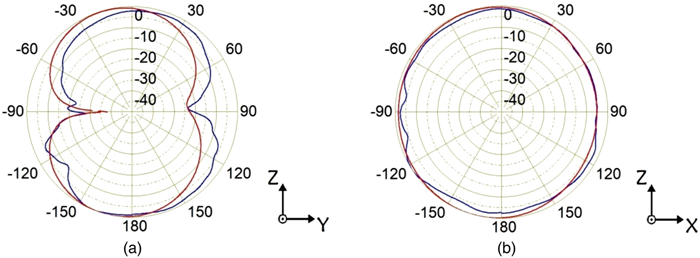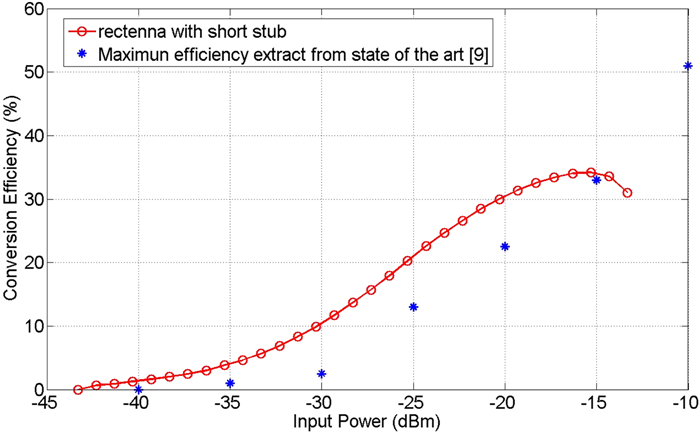-
About this article
Cite this article
Zhou Y, Froppier B, Razban T. 2015. Radiofrequency ambient level energy harvesting. Wireless Power Transfer 2(2): 121–126 doi: 10.1017/wpt.2015.8
Radiofrequency ambient level energy harvesting
Abstract: This paper presents a study of Schottky diode rectenna (rectifying antenna) for radiofrequency (RF) energy-harvesting systems. These rectennas are suitable for wireless sensors with the rechargeable battery technology especially at low-power densities. A rectifying circuit is proposed with single high responsivity Schottky diode for RF–DC conversion. A matching circuit is optimized to improve not only the power transfer between the antenna and the diode, but also to reject harmonic signals. The radiating part is a monopole antenna, with a large bandwidth in the frequency domain and an omni-directional radiation pattern in the azimuthal plane. We show that antenna frequency response takes part in the improvement of the efficiency. The rectifier is integrated with the antenna on a printed circuit board, leading to 30% of size reduction with the same performance. The aim is to reach the highest efficiency with a single tone signal and a compact rectenna. This rectenna was simulated using both Agilent ADS and Ansoft HFSS software. An output DC voltage of 210 mV was measured inside an anechoic chamber which received a single tone signal of 2 μW/cm2 power density. The highest efficiency of 34% was obtained at a power density of 1.3 μW/cm2.
-
Key words:
- Energy harvesting /
- Rectenna /
- Schottky diode /
- Broaband antenna /
- High efficiency









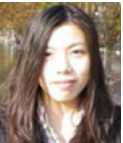 Yuwei Zhou was born in Jiangxia District, Wuhan, China, in 1986. She received her Master degree from Ecole Polytechnique of the University of Nantes, in 2010. She received her Ph.D. from the same university in 2013. She is now working as an Assistant Professor in the University of Hankou in Jiangxia District, Wuhan, China. Her research interests are mainly focused on the antennas and high-frequency circuits.
Yuwei Zhou was born in Jiangxia District, Wuhan, China, in 1986. She received her Master degree from Ecole Polytechnique of the University of Nantes, in 2010. She received her Ph.D. from the same university in 2013. She is now working as an Assistant Professor in the University of Hankou in Jiangxia District, Wuhan, China. Her research interests are mainly focused on the antennas and high-frequency circuits.  Bruno Froppier was born in France in 1973. He received his Master degree from the University of Nantes in 1999. He received his Ph.D. from the University of Nantes in 2004. He was working as a Research Engineer for a company in 2006. Since he is an Associate Professor at the University of Nantes/IUT of La Roche-sur-Yon, his research interests are mainly focused on the antennas, high-frequency circuits, and wireless energy harvesting.
Bruno Froppier was born in France in 1973. He received his Master degree from the University of Nantes in 1999. He received his Ph.D. from the University of Nantes in 2004. He was working as a Research Engineer for a company in 2006. Since he is an Associate Professor at the University of Nantes/IUT of La Roche-sur-Yon, his research interests are mainly focused on the antennas, high-frequency circuits, and wireless energy harvesting. 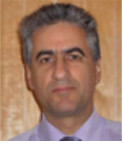 Tchanguiz Razban was born in Tabriz, Iran, in 1956. He received his Engineering degree from the University of Tehran, Iran, in 1980. He received his Ph.D. and Doctorat d'Etat from Institut National Polytechnique de Grenoble (INPG), France, in 1983 and 1989, respectively. He was then an Associate Professor in the University of Nice until 1993. He is presently a full Professor of Electrical Engineering at Ecole Polytechnique de Nantes. Since 1999, he has been the Dean of Electrical Engineering Department, Deputy Director and finally Director of Ecole Polytechnique until January 2010. He is now the Director of International affairs of Polytech Nantes. He is a researcher at the Institute of Electronics and Telecommunications of Rennes (IETR) since 1993. He is the author or co-author of more than 70 papers in international journals and conference proceedings. His research interests are mainly focused on the antennas and high-frequency circuits
Tchanguiz Razban was born in Tabriz, Iran, in 1956. He received his Engineering degree from the University of Tehran, Iran, in 1980. He received his Ph.D. and Doctorat d'Etat from Institut National Polytechnique de Grenoble (INPG), France, in 1983 and 1989, respectively. He was then an Associate Professor in the University of Nice until 1993. He is presently a full Professor of Electrical Engineering at Ecole Polytechnique de Nantes. Since 1999, he has been the Dean of Electrical Engineering Department, Deputy Director and finally Director of Ecole Polytechnique until January 2010. He is now the Director of International affairs of Polytech Nantes. He is a researcher at the Institute of Electronics and Telecommunications of Rennes (IETR) since 1993. He is the author or co-author of more than 70 papers in international journals and conference proceedings. His research interests are mainly focused on the antennas and high-frequency circuits 


